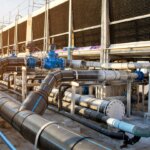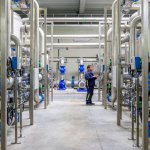Data center water sustainability needs highlighting

Some might say that improving data center efficiency is a job that’s almost done. Hyperscale designs have paved the way for huge gains in power usage effectiveness (PUE). The needle has moved strongly in the direction of systems performance, with non-IT energy representing a smaller slice of the power consumption pie. Massive data center facilities have become exemplars in optimization. At Google, this extends to custom-designed high-voltage substations. Big players have realized that off-the-shelf components only go so far when it comes to maximizing energy efficiency. And fully integrated approaches carry the data center design philosophy all the way from how servers are cooled in the racks, the heat management solutions that they mate to, and the cooling plant operation itself. But reporting on PUE alone misses important details such as data center water sustainability.
Resource constraints
Effectively, data center operators have become experts in cost management. But in today’s increasingly resource-constrained world, that metric needs bolstering. Data center customers with environmental, social, and corporate governance (ESG) strategies to fulfill are wanting alternative measures of data center efficiency. These include carbon usage effectiveness (CUE), which tends towards zero as the data center becomes capable of running on 100% renewable power. Rising power costs and a desire for energy security have ramped up investment by data center operators in wind, solar, and other renewable schemes. However, it’s not power, but water that could turn out to be the biggest concern.
For more than 15 years, analysts have been warning about the gap between global water supply and demand. When initiatives such as ‘2030 Water Resources Group’ – a 1000 partner organization hosted by the World Bank to help countries achieve water security – was formed in 2008, the data center landscape looked very different. Big operators had just gotten started. Google’s first owned and operated data center went online in 2006.
Cooling represents a significant overhead for data center operators, and naturally, they are keen to keep these numbers as low as they can. Joe Kava, VP of Data Centers at Google, notes that the firm has innovated its cooling systems about every 18 months since he joined the firm in 2008. Google, like other data center operators, is looking at a variety of options including reclaimed and stormwater. Google’s data center on the Gulf of Finland uses seawater that’s around 14 degC to provide 100% cooling for the facility.
Data center water sustainability
Data centers can use millions of litres of water a day, but volume isn’t the only consideration. The keyword is ‘sustainability’. Writing in the peer-reviewed journal NPJ Clean Water, David Mytton – a visiting researcher at Imperial College London’s Centre for Environmental Policy – has been considering data center water consumption in detail. Mytton acknowledges that some progress has been made with using recycled and non-potable water, which ties in with progress reported by Google. But overall, the industry has scope to do more. In fact, data center operators could be drawing more than half of their water from potable sources, according to figures cited by Mytton. And a mixed approach to reporting data center water consumption doesn’t help either. Organizations want transparency, including the European Commission (EC).
Reporting to the EC in the summer of 2022, Climate Neutral Data Centre Pact (CNDCP) – a group comprising 74 data center operators and 23 associations in Europe – announced that it has set a limit on water use at 0.4L/kWh. And the self-regulatory initiative expects all signatories to achieve the metric by 2040. Reduced water consumption is a sensible target, but only alongside other measures. In cooler climates, the target will apply from 2025 and the measure encourages cooling alternatives to the use of fresh drinking water such as grey water and rainwater. Metrics will be needed to capture this progress. And companies should be able to record their achievements.
Five years ago, The National Renewable Energy Laboratory (NREL), US, demonstrated the value of thermosyphon cooling in reducing water consumption at its high-performance computing data center by half. The design, which was prototyped in 2016, uses refrigerant in a passive cycle to dissipate heat with operators only needing to use wet cooling in hot weather. Just as the shift to lower and lower PUE values took time, improvements in water usage won’t happen overnight, but there are promising signs. And competition for customers could spur the trend.
Microsoft has made a pledge to be water positive by 2030 – replenishing more water than it uses. And other operators are considering ecosystem protection and restoration programs. Certainly, there are examples to follow from other industries. In 2018, Coca Cola announced that it was the first Fortune 500 company to replenish all the water it uses globally.
Adding water conservation to pledges to be 100% renewable powered, is appealing to data center customers. And with the ingenuity that cloud providers have in abounds, their prospects for finding winning solutions are strong. The pace of change has been dramatic, powering tremendous improvements in energy efficiency. And now is the time to apply a similar thought process to data center water sustainability.









